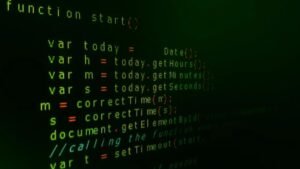Generative Music Musicians
Generative music is a form of music composition that uses algorithms and rules to create unique and ever-changing musical pieces. It is a type of music that is continuously evolving and never repeated exactly the same way. This innovative approach to music has gained traction in recent years, with many musicians embracing generative music as a way to explore new creative possibilities.
Key Takeaways:
- Generative music uses algorithms and rules to create unique and ever-changing musical pieces.
- Many musicians are embracing generative music as a way to explore new creative possibilities.
- Generative music opens up opportunities for dynamic and interactive performances.
Generative music allows musicians to break free from traditional composition methods and explore uncharted territories. By utilizing algorithms to generate melodies, harmonies, and rhythms, musicians can create intricate and complex musical compositions with minimal effort. This approach allows for a more experimental and spontaneous approach to music creation, resulting in unique and unexpected results. *Generative music invites the listener on a journey of sonic exploration, where no two compositions are ever the same.*
One of the key advantages of generative music is its ability to provide endless variations and possibilities. The algorithms used in generative music can be programmed to react to external stimuli, such as input from sensors or audience interactions. This opens up opportunities for dynamic and interactive performances, where the music is responsive to its surroundings and adapts in real-time. Generative music also allows for generative sound design, where the composition itself influences the sound design process, creating a cohesive and immersive sonic experience. *By harnessing the power of algorithms, generative music creates a symbiotic relationship between the musician, the composition, and the listener.*
Table 1: Comparison of Traditional Composition and Generative Music
| Traditional Composition | Generative Music |
|---|---|
| Fixed composition | Ever-evolving composition |
| Repetitive structure | Endless variations |
| Linear progression | Non-linear exploration |
Generative music has also found its place in various forms of media, including film, video games, and installations. Its ability to create immersive and atmospheric soundscapes makes it a perfect fit for enhancing visual experiences. In the realm of interactive media, generative music can respond directly to user inputs, creating unique soundtracks tailored to individual interactions. This dynamic and adaptive nature of generative music elevates the overall experience, allowing for a deeper connection between the audience and the content. *Generative music breathes life into the digital realm, enhancing the emotional impact of visual media through its ever-evolving sonic landscapes.*
Table 2: Applications of Generative Music
| Film | Video Games | Installations |
|---|---|---|
| Enhances emotional impact of scenes | Creates dynamic soundtracks | Creates immersive soundscapes |
| Supports narrative development | Responds to user interactions | Engages with physical space |
Generative music is not limited to a specific genre or style. It can be applied to various musical genres, from ambient and electronic music to classical and jazz. Its flexibility allows musicians to push artistic boundaries and explore innovative ways of creating and performing music. Moreover, generative music offers opportunities for collaboration between musicians and programmers, as the marriage of technology and music becomes increasingly prevalent. *Generative music transcends traditional genre boundaries, fostering creativity and experimentation across musical landscapes.*
The continued development of generative music technology and its integration into various creative fields ensure that its influence will only continue to grow. As the digital age expands and technology becomes more accessible, generative music will likely find its way into the mainstream consciousness, creating new artistic possibilities and captivating audiences with its ever-changing and unpredictable nature. *Generative music is an exciting and evolving field that promises to shape the future of music composition and performance.*
Table 3: Advancements in Generative Music Technology
| Real-time adaptation | Interactive performance | Collaborative tools |
|---|---|---|
| Algorithms react to external stimuli | Music adapts to audience interactions | Integration of music and technology |
| Dynamic sound design | User-driven compositions | Symbiotic relationship between musician and technology |
Generative music musicians have embraced this innovative approach to music composition, pushing the boundaries of what is possible and redefining the artistic landscape. With its ever-evolving nature and endless possibilities, generative music continues to captivate audiences and inspire musicians to explore new creative territories. As technology advances and generative music becomes more accessible, we can expect to witness even more groundbreaking works that challenge our notions of what music can be. *Generative music musicians are at the forefront of a creative revolution, shaping the future of music in exciting and unpredictable ways.*

Common Misconceptions
Generative Music Musicians
There are several common misconceptions people have about generative music musicians. Let’s debunk some of these misconceptions:
Misconception 1: Generative music is just random noise
- Generative music is carefully crafted and composed, not random noise
- Artists use algorithms and systems to create unique musical patterns and structures
- Generative music can be melodic, rhythmic, and harmonious, depending on the artist’s intentions
Misconception 2: Generative music musicians lack skill and talent
- Generative music is a different approach to composition and requires a deep understanding of music theory
- Artists must have programming skills to develop algorithms and systems for their music
- Performing generative music live requires skill and improvisation to control and shape the musical output
Misconception 3: Generative music musicians are not real musicians
- Generative music musicians are indeed real musicians who create unique musical experiences
- They utilize their musical knowledge along with technology to craft complex compositions
- Their music can evoke emotions and transport listeners, just like any other form of music
Misconception 4: Generative music lacks creativity and human touch
- Generative music is a tool used by musicians to enhance their creative process, not replace it
- Artists infuse their personal style and artistic decisions into the generative systems they create
- Generative music can produce unexpected and unique results that humans alone may not have thought of
Misconception 5: Generative music is only for background or ambient music
- While generative music is often used in ambient and background settings, it can be applied to various genres
- Artists experiment with different styles, from classical to electronic, using generative techniques
- Generative music can be engaging and captivating, commanding full attention from the listener

Generative Music Musicians – Major Albums Released
Here is a list of major albums released by prominent generative music musicians. These albums have made significant contributions to the field and have gained widespread recognition and acclaim.
| Musician | Album | Year |
|---|---|---|
| Brian Eno | Ambient 1: Music for Airports | 1978 |
| Aphex Twin | Selected Ambient Works 85-92 | 1992 |
| Kraftwerk | Autobahn | 1974 |
| Tim Hecker | Virgins | 2013 |
| Hiroshi Yoshimura | Green | 1986 |
Generative Music Techniques – Commonly Used by Musicians
Generative music musicians employ various techniques to create their unique compositions. These techniques often involve the use of technology, algorithms, and creative experimentation. The table below highlights some commonly used techniques in the field.
| Technique | Description |
|---|---|
| Probability-based composition | Using probability functions and randomization to determine musical elements. |
| Algorithmic patterns | Creating music based on predefined algorithms and patterns. |
| Data mapping | Mapping external data sources to musical parameters for generating compositions. |
| Recursive structures | Implementing music structures that recursively generate new musical material. |
| Feedback loops | Creating generative systems that utilize feedback to evolve musical patterns. |
Generative Music Artists – Popularity on Streaming Platforms
Generative music artists have gained significant popularity on various streaming platforms, reflecting the growing interest in this unique genre. The table below illustrates the number of monthly listeners for some popular generative music artists.
| Artist | Monthly Listeners |
|---|---|
| Brian Eno | 2,500,000+ |
| Aphex Twin | 1,800,000+ |
| Tim Hecker | 870,000+ |
| Hiroshi Yoshimura | 450,000+ |
| Max Richter | 380,000+ |
Collaborations in Generative Music – Notable Partnerships
Collaborations between generative music musicians have led to remarkable musical experiences that blend different artistic styles and approaches. The table below presents some notable partnerships in the world of generative music.
| Collaborators | Project/Album | Year |
|---|---|---|
| Brian Eno & Peter Chilvers | Bloom | 2008 |
| Aphex Twin & Philip Glass | Orphée | 2021 |
| Tim Hecker & Daniel Lopatin | Instrumental Tourist | 2012 |
| Hiroshi Yoshimura & Hideki Matsutake | Something Blue | 1986 |
| Max Richter & Robert Wyatt | Waltz with Bashir: Original Soundtrack | 2008 |
Generative Music Applications – Fields of Utilization
Generative music has found applications in various fields beyond traditional music production. These applications highlight the versatility and potential impact of generative music techniques. The table below showcases some notable fields where generative music has been utilized.
| Application Field | Description |
|---|---|
| Art installations | Creating interactive soundscapes and audiovisual experiences. |
| Meditation and mindfulness | Designing calming and ambient soundtracks for meditation and relaxation purposes. |
| Video games | Generating adaptive soundtracks that respond to gameplay and player interactions. |
| Therapeutic applications | Using generative music for therapeutic purposes, such as music therapy and stress reduction. |
| Virtual reality experiences | Enhancing virtual reality environments with dynamic and immersive generative sound. |
Generative Music Technologies – Innovations in the Field
Advancements in technology have greatly contributed to the development of generative music, enabling musicians to explore new frontiers in sound creation and experimentation. The table below highlights some groundbreaking technologies and innovations in the field.
| Technology/Innovation | Description |
|---|---|
| Machine learning | Utilizing artificial intelligence algorithms to analyze and generate musical patterns. |
| Spatial audio systems | Creating immersive soundscapes with 3D audio positioning and movement capabilities. |
| Mobile apps | Developing user-friendly generative music apps for on-the-go creativity and exploration. |
| Neural networks | Implementing neural networks to generate complex and evolving musical compositions. |
| Generative hardware | Designing specialized hardware devices for real-time generative music performance. |
Influence of Generative Music – Notable Genres and Artists
Generative music has had a profound impact on various genres and has influenced numerous artists across different musical landscapes. The table below showcases some notable genres and the artists who have embraced generative music within their works.
| Genre | Artists |
|---|---|
| Ambient | Brian Eno, Tim Hecker, Hiroshi Yoshimura |
| IDM (Intelligent Dance Music) | Aphex Twin, Autechre, Squarepusher |
| Experimental | John Cage, Alva Noto, Ryoji Ikeda |
| Post-rock | Tortoise, Godspeed You! Black Emperor, Explosions in the Sky |
| Contemporary classical | Max Richter, Arvo Pärt, Ólafur Arnalds |
Emerging Generative Music Musicians – Rising Stars
The generative music landscape continues to evolve with a new generation of talented musicians pushing the boundaries of the genre. The table below showcases some emerging generative music musicians who are gaining recognition for their innovative works.
| Musician | Notable Albums |
|---|---|
| Kelly Moran | Ultraviolet, Bloodroot, Optimist |
| Kaitlyn Aurelia Smith | The Kid, EARS, Euclid |
| Ian William Craig | Slow Vessels, Red Sun through Smoke, Centres |
| Yves Tumor | Heaven To A Tortured Mind, Serpent Music, Safe in the Hands of Love |
| Visible Cloaks | Reassemblage, Lex, Visible Cloaks |
Conclusion
Generative music has revolutionized the art of composition, introducing novel techniques and technologies that challenge traditional notions of music creation. The fusion of human creativity with algorithmic systems has led to groundbreaking albums, collaborations, and applications in various fields. With the influence of generative music continuing to grow, both established artists and rising stars are shaping the future of the genre, ensuring its evolution and relevance in the ever-changing musical landscape. The tables presented in this article provide a glimpse into the vibrant world of generative music, showcasing the achievements and impact of musicians who have paved the way for this captivating genre.
Frequently Asked Questions
Generative Music Musicians
What is generative music?
What tools or software can I use to create generative music?
Can I perform generative music live?
Is generative music limited to electronic genres?
Can generative music be used for background music in films or games?
What are some well-known musicians who create generative music?
Do I need coding skills to create generative music?
How can I get started with generative music?
Can generative music compositions be recorded or released?
What are the advantages of generative music?




